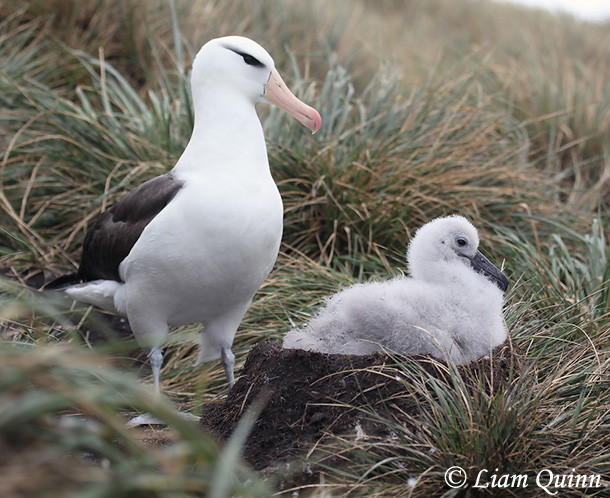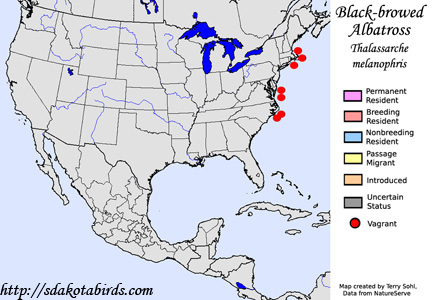| Length: 32-36 inches | Wingspan: 80 - 90 inches | Seasonality: Non-resident in South Dakota |
| ID Keys: Adult - Wings and mid-back are dark grey, rest of plumage white except for dark "eyebrow". Bill is yellowish-orange with reddish tip. | ||
 The
Black-browed Albatross is a moderately sized albatross of the southern
oceans. They can be found throughout the southern hemisphere, but a
majority of breeding birds are found on a few select islands in the south
Atlantic (Falkands, South Georgia). They are rare vagrants north of
the equator, but there have been more than 20 sightings of the species off
the east coast of the United States.
The
Black-browed Albatross is a moderately sized albatross of the southern
oceans. They can be found throughout the southern hemisphere, but a
majority of breeding birds are found on a few select islands in the south
Atlantic (Falkands, South Georgia). They are rare vagrants north of
the equator, but there have been more than 20 sightings of the species off
the east coast of the United States.
Habitat: For breeding, prefers islands with grassy slopes, but also will utilize flat lands and rocky ledges for nesting. Outside of the breeding season, they are pelagic, typically found far from land.
Diet: Feeds on fish, squid, crustaceans, octopus, and other marine creatures.
Behavior: Most foraging is done by sitting on the ocean's surface and reaching down to grab food items when spotted. They also will sometimes submerge to grab prey, and will occasionally dive from flight to reach deeper prey.
Nesting: The nest is a mound of mud and moss, typically placed on a grassy slope on breeding islands. The female lays one egg, which is incubated by both parents. The chick hatches after a 2-month incubation period. Both the male and female tend to and feed the chick.
Interactive eBird Map: Click to access an interactive eBird map of Black-browed Albatross sightings
Song: Usually silent when at sea.
Migration: Breeds in large colonies, with the Falkland Islands and South Georgia Island in the south Atlantic hosting 80% of the world's breeding pairs. Breeding also occurs on islands in the southern Indian Ocean and southern Pacific Ocean. In other seasons, roams widely in the southern oceans, only occasionally being found north of the equator.
Similar Species: As a vagrant near North America, they are most likely to be confused with the Short-tailed Albatross and Laysan Albatross.
Conservation Status: Populations of Black-browed Albatross have plummeted in recent decades. Longline fishing has severely impacted many albatross species, but the Black-browed Albatross is one of the most common victim of longline fishing in many areas. The IUCN lists the Black-browed Albatross as "Endangered".
Further Information: 1) Birdlife.org - Black-browed Albatross
2) Australian Government Profile - Black-browed Albatross
3) ARKive.org - Black-browed Albatross
Photo Information: Photo taken by Liam Quinn - Licensed under Creative Commons Attribution-Share-Alike 2.0 Generic License.
| Click below for a higher-resolution map |
 |
| South Dakota Status: Non-resident in South Dakota |
Additional Black-browed Albatross Photos (coming soon!!)
